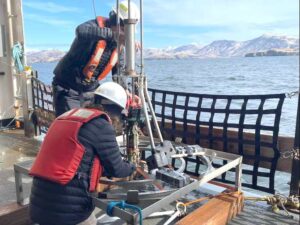
Harmful algal blooms (HABs) have long been prevalent in the waters off the Kodiak archipelago, with the toxins produced by species such as Alexandrium catenella historically posing a threat to the health of communities. Alexandrium produces saxitoxin, a neurotoxin which can accumulate in shellfish and cause severe illness or death in those who consume it. The prevalence of Alexandrium blooms is likely to increase with climate change and threatens culturally and commercially shellfish harvests. Rural native communities are at particularly high risk from HABs due to the importance of subsistence shellfish harvests and lack of access to emergency medical services.
To help the Kodiak region understand and adapt to the increased presence of Alexandrium, a consortium of agencies has begun a 5-year project to study and predict changing harmful algal bloom patterns. Called the “Monitoring and Event Response for Harmful Algal Blooms” research program (MERHAB), this federally funded program joins the National Oceanic and Atmospheric Administration (NOAA) with the University of Alaska and the Kodiak Area Native Association (KANA) to understand HABs in the Kodiak archipelago. This past March, the project kicked off with a 12-day cruise around the Kodiak archipelago on the NOAA vessel Oscar Dyson.
Jake Cohen, an Alaska Sea Grant State Fellow working with KANA, had the opportunity to join the recent Oscar Dyson cruise. Cohen’s fellowship is focused on creating a long-term plan for tribal ocean-acidification sampling on Kodiak Island. “I hadn’t expected to go to sea during my fellowship, but I immediately said yes when offered,” Cohen said of the cruise. “Although we weren’t studying ocean acidification, assisting tribes as they adapt to climate change will require synthesis of different types of environmental monitoring. Beyond that, time at sea will let me work with partners from different agencies and see some remote parts of this island where I live.”
Interagency cooperation is a hallmark of the MERHAB program. Researchers from NOAA and the University of Alaska bring scientific capacity to the project, including access to research vessels and sophisticated laboratory analysis. Meanwhile, KANA, an inter-tribal consortium providing healthcare, community services, and economic development throughout the Kodiak Island Archipelago, works closely with Kodiak’s tribes and village communities to utilize the findings of the MERHAB project to ensure safe harvest of shellfish. As Alaska’s maritime environment transforms from the impacts of climate change, this collaboration and sharing of knowledge will be vital to creating an equitable transition to sustainable and resilient coastal communities.
Onboard the Oscar Dyson, researchers collected sediment cores to analyze for the presence of Alexandrium cysts. Sampling occurred around the Kodiak archipelago, with particular focus on the bays and nearshore waters around tribal villages. This was the first of several planned cruises, and the mapping of Alexandrium will help to create a forecasting model for HABs in Kodiak waters. This preemptive warning of seawater conditions may inform communities when it is safer to harvest shellfish, allowing for informed subsistence practices integral to life in rural Alaska.
“My hope was to use my oceanography skills on a project that is important for communities in Alaska,” said Cohen about his time on the cruise. “Projects like this one are letting me use my fellowship to not only build professional connections but conduct research that is directly applicable to the communities we serve.”
